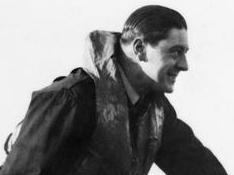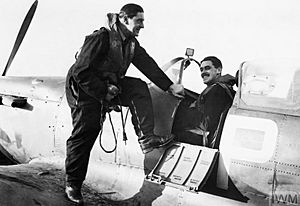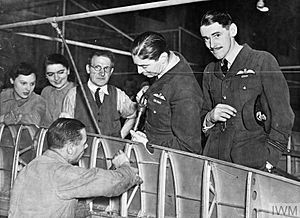Harbourne Stephen facts for kids
Quick facts for kids
Harbourne Mackay Stephen
|
|
|---|---|
 |
|
| Born | 18 April 1916 Elgin, Scotland |
| Died | 20 August 2001 (aged 85) London, United Kingdom |
| Allegiance | United Kingdom |
| Service/ |
Royal Air Force Volunteer Reserve |
| Rank | Wing Commander |
| Commands held | No. 166 Wing No. 602 Squadron No. 234 Squadron |
| Battles/wars | Second World War
|
| Awards | Commander of the Order of the British Empire (Civil division) Distinguished Service Order Distinguished Flying Cross & Bar Mention in despatches Air Efficiency Award |
| Other work | Newspaperman |
Harbourne Mackay Stephen CBE, DSO, DFC*, AE (1916–2001) was a brave British flying ace during the Second World War. He was part of the Royal Air Force Volunteer Reserve (RAFVR). A flying ace is a pilot who has shot down five or more enemy aircraft. Stephen was officially credited with destroying at least nine enemy planes by himself.
Born in Elgin, Scotland, Stephen joined the RAFVR in 1937. When the Second World War began in 1939, he joined the Royal Air Force (RAF). He flew with No. 605 Squadron and then No. 74 Squadron. He played a big part in the evacuation from Dunkirk and the Battle of Britain. During the Battle of Britain, he destroyed at least four German aircraft. He received the Distinguished Flying Cross twice and the Distinguished Service Order for his bravery.
After 1940, he trained other pilots for a while. Later, he joined No. 234 Squadron and flew missions attacking radar sites in France. He achieved his last aerial victory in October 1941. When Japan entered the war, he went to the Far East. There, he led No. 166 Wing and worked in other important roles. After the war, he went back to his old job in the newspaper business. He managed several newspapers and was honored with the Commander of the Order of the British Empire award in 1985 for his work.
Contents
Early Life and Joining the RAF
Harbourne Mackay Stephen was born in Elgin, Scotland on 18 April 1916. His father was a bank manager. Harbourne went to schools in Edinburgh and Shrewsbury. He finished school at 15 and moved to London to work in the newspaper industry.
He first worked as a copy boy for Allied Newspapers. In 1936, he started working in advertising for the Evening Standard newspaper. In April 1937, he joined the Royal Air Force Volunteer Reserve (RAFVR). This was a group for people who wanted to learn to fly and serve in the RAF part-time. He learned to fly at a special school. He took six months off from his job to train with the Royal Air Force (RAF). His training finished just as the Second World War started in September 1939.
Second World War Adventures
When the war began, Stephen was called up for full-time service in the RAF. He trained on the Hawker Hurricane fighter aircraft in Wales. Then, he joined No. 605 Squadron as a sergeant pilot. His squadron didn't see much action until March 1940. They tried to stop a German Heinkel He 111 bomber, but another squadron finished the job.
Helping at Dunkirk
On 1 April, Stephen became a pilot officer and moved to No. 74 Squadron. This squadron flew Supermarine Spitfire fighters. They were based at Hornchurch. Stephen flew many missions during the evacuation from Dunkirk. This was when many Allied soldiers were rescued from France.
- On 24 May, he helped shoot down a German Henschel Hs 126 plane near Dunkirk. He also helped destroy a Dornier Do 17 bomber near Calais.
- Two days later, he shared in destroying another Hs 126.
- On 27 May, he shot down a Messerschmitt Bf 109 fighter near Dunkirk. He then helped destroy another Do 17 near Boulogne.
Fighting in the Battle of Britain

No. 74 Squadron was very busy when the Battle of Britain started in July 1940. This battle was fought in the skies over Britain.
- On 28 July, Stephen damaged a Bf 109.
- On 11 August, he destroyed one Bf 109, damaged another, and also damaged a Messerschmitt Bf 110 over Dover.
- On 13 August, he probably destroyed a Do 17 over the Thames Estuary.
In mid-August, his squadron moved for a rest. Two weeks later, Stephen received the Distinguished Flying Cross (DFC). This award is given for "an act or acts of exemplary gallantry during active operations against the enemy in the air". The official announcement said he had destroyed 12 enemy aircraft and showed great courage.
No. 74 Squadron returned to duty in September. Stephen continued to succeed against the German Luftwaffe (air force).
- On 11 September, he destroyed a Junkers Ju 88 bomber and damaged a Bf 109 over London.
- In early October, he damaged a He 111.
- On 5 October, he shared in destroying a Do 17.
- On 20 October, he destroyed a Bf 109 and probably destroyed another.
- A week later, he destroyed another Bf 109.
- On 14 November, he shot down three Junkers Ju 87 dive bombers over Dover.
- The next day, he damaged a Bf 109.
He was then awarded a bar to his DFC, meaning he received the award a second time. The award said he had destroyed at least 13 enemy aircraft and was a great inspiration to his squadron.
- On 17 November, Stephen shared in destroying a Bf 109 near Brighton.
- At the end of November, he shared in shooting down another Bf 109 near the Thames Estuary. This was the 600th victory for squadrons flying from Biggin Hill, shared with fellow flying ace John Mungo-Park.
- In early December, he probably destroyed a Bf 109.
- On 5 December, he destroyed a Bf 109 and shared in shooting down another.
On 24 December, he received the Distinguished Service Order (DSO). This was a very high award for leadership and bravery. It was his third bravery award in just six months! The award noted his courage and skill, and that he had increased his own score to 19 aircraft destroyed.
Later War Service
On 11 January 1941, Stephen stopped flying combat missions. He became the chief flying instructor at a training unit in Edinburgh. He was later promoted to flying officer.
In June, Stephen returned to combat operations with No. 130 Squadron. In July, he became the commander of No. 234 Squadron. His squadron flew missions to attack German radar sites in France and protect convoys.
- On 12 August, he damaged a Ju 88 near Antwerp.
- On 15 October, he and another pilot shared in destroying a Bf 109 near Le Havre. This was his last aerial victory.
In early 1942, after Japan joined the war, Stephen went to the Far East. He led a group of planes at Dum Dum in India. On 14 July, he was promoted to squadron leader. He then commanded No. 166 Wing during the Burma campaign. He also held staff jobs, helping to plan air operations.
By the end of the war, Stephen was a wing commander. He was credited with nine solo aerial victories and eight shared victories. He also damaged many other enemy planes.
Life After the War
After the war, Stephen decided not to stay in the RAF. He went back to working in newspapers. He became a manager at the Scottish Daily Express and other newspapers in Glasgow.
In September 1950, he returned to the RAFVR part-time. He became the commander of No. 602 (City of Glasgow) Squadron until 1952.
In 1956, Stephen became the general manager of the Sunday Express. Three years later, he managed The Sunday Times. He helped introduce a color magazine with the newspaper. In 1963, he became managing director at The Daily Telegraph. In 1985, he was made a Commander of the Order of the British Empire (CBE) for his important work in the newspaper industry.
Stephen was also interested in helping others. He helped start the Raleigh International charity, which helps young people get involved in environmental and community projects. He was also part of the Royal Society for the Protection of Birds and the Scientific Exploration Society. Harbourne Mackay Stephen passed away in London on 20 August 2001. He was survived by his wife, Erica, and their two children.


